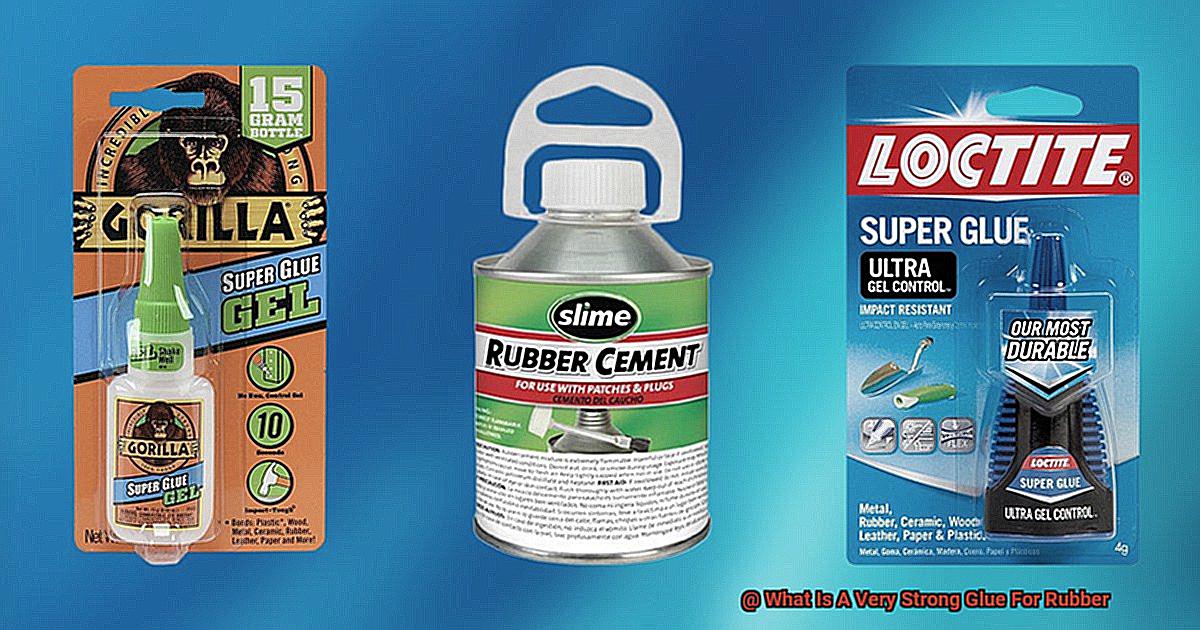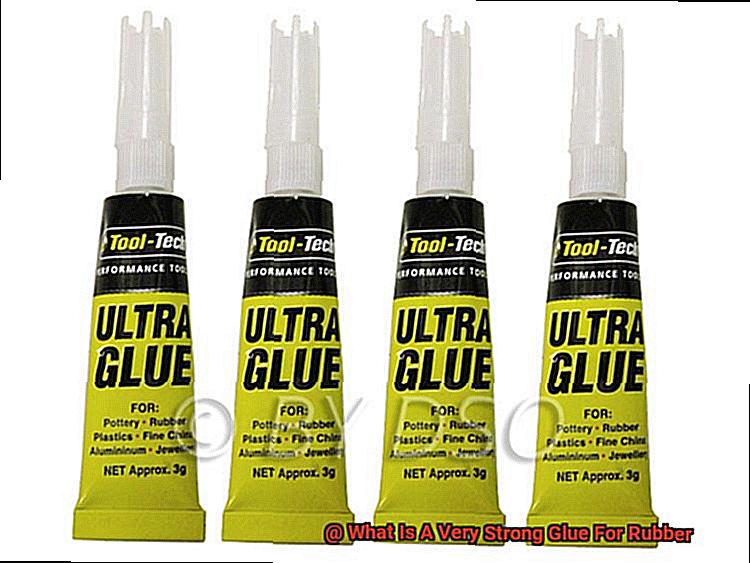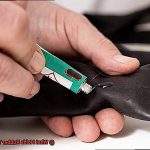Are you tired of getting stuck in sticky situations with rubber materials?
Whether it’s fixing your favorite sneaker or patching up a leaky hose, finding the right glue for rubber is crucial. But fear not, because there are some seriously powerful solutions out there that can handle anything you throw at them.
In this blog post, we’re going to explore the wonders of super strong rubber glue and why it’s an absolute must-have in your toolkit. Say goodbye to temporary fixes and hello to long-lasting durability as we dive into the world of unbreakable bonds.
Get ready to stretch your knowledge on this subject, because we’re about to embark on an informative journey together.
What is Rubber?
Contents
Rubber is a remarkable material that has become an essential part of our daily lives. Derived from the sap of the rubber tree, it is a natural polymer composed of long chains of elastomers. These elastomers give rubber its extraordinary properties of elasticity, strength, and resistance to wear and chemicals.
Rubber has found its way into countless applications due to its versatility and durability. From automotive tires to industrial gaskets, rubber products are crucial components in many industries. But what makes rubber so unique?

Firstly, the molecular structure of rubber is what gives it its exceptional elasticity. The long chains of elastomers allow rubber to stretch and then return to its original shape effortlessly. This property makes rubber ideal for applications where flexibility and durability are paramount.
Furthermore, rubber exhibits outstanding resistance to wear, abrasion, and corrosion. It can withstand exposure to extreme temperatures, making it suitable for use in both hot and cold environments. Rubber also possesses excellent chemical resistance, making it impervious to acids, bases, oils, solvents, and a wide range of substances.
When it comes to bonding rubber materials, choosing the right adhesive is crucial. Several types of adhesives have proven effective in forming strong bonds with rubber surfaces:
Cyanoacrylate glue, commonly known as super glue, dries quickly and forms a strong bond with rubber. However, it is essential to use a specific formulation designed for rubber bonding.
Epoxy adhesives consist of two components – the resin and the hardener – which need to be mixed together before application. Once applied, epoxy cures and forms a robust bond with the rubber surface. Epoxy adhesives offer excellent resistance to heat, chemicals, and moisture.
Polyurethane-based adhesives are highly effective in bonding rubber materials due to their exceptional strength and flexibility. They can withstand dynamic loads and vibrations, making them ideal for automotive applications and repairing rubber products.
Silicone-based adhesives provide excellent flexibility and resistance to high temperatures. They are suitable for applications that involve exposure to extreme heat or harsh conditions, such as in the aerospace or electronics industries.
Choosing the right adhesive for rubber bonding depends on various factors, including the type of rubber, desired bond strength, flexibility requirements, and environmental conditions. Consulting with a knowledgeable supplier or manufacturer can help in selecting the most appropriate adhesive for specific needs.
Types of Glue for Rubber Bonding
When it comes to bonding rubber, it is important to choose a strong adhesive that can create a durable and long-lasting bond. Here are some options for glues commonly used for rubber bonding:
Cyanoacrylate Adhesives (Super Glue)
Cyanoacrylate adhesives, also known as super glue, are known for their fast-setting and excellent adhesion strength. They form a strong bond with rubber materials, making them suitable for various applications. However, it is important to choose a super glue specifically designed for rubber bonding.
Epoxy Adhesives
Epoxy adhesives are known for their high strength and durability. They consist of two components – resin and hardener – that need to be mixed before application. Epoxy adhesives offer excellent chemical resistance and can create a strong bond between rubber and other materials.
Polyurethane Adhesives
Polyurethane adhesives provide exceptional strength and flexibility. They can bond a wide range of materials, including rubber, and are commonly used in construction, automotive, and industrial applications. While they require a longer curing time compared to other glues, polyurethane adhesives offer superior strength once fully cured.
Contact Adhesives
Contact adhesives have high initial tack and provide a very strong bond for rubber materials. These adhesives are applied to both surfaces that need bonding and allowed to dry before joining them together. Once the adhesive surfaces come into contact, they form an instant bond.
Silicone Adhesives
Silicone adhesives are flexible and resistant to extreme temperatures. They bond various types of rubber materials and offer good adhesion strength. Silicone adhesives are often used in automotive applications due to their ability to withstand the heat generated by engines and other mechanical components.
Cyanoacrylate Glue (Super Glue)
Cyanoacrylate glue, also known as super glue, is a remarkable adhesive that offers numerous advantages for bonding rubber surfaces. Its fast curing time, exceptional strength, and resistance to temperature and chemicals make it an ideal choice for various applications. Here’s a closer look at the advantages of cyanoacrylate glue and some tips for proper use on rubber:
Advantages:
- Fast Curing: When exposed to moisture in the air, cyanoacrylate glue cures rapidly, allowing for quick bonding of rubber surfaces. This makes it a convenient choice for projects that require immediate results.
- Exceptional Strength: The bond formed by cyanoacrylate glue is incredibly strong and can withstand significant stress and tension. Whether you’re repairing a torn rubber sole or bonding rubber components in an industrial setting, super glue offers reliable durability.
- Resistance to Temperature and Chemicals: Super glue can withstand extreme temperatures without losing its adhesive properties. Additionally, it remains stable when exposed to oils or solvents, making it suitable for applications that involve contact with various chemicals.
Proper Use:
- Surface Preparation: Before applying cyanoacrylate glue, ensure that the bonding surfaces are clean, free from dirt, grease, or moisture. Thoroughly clean the rubber surfaces using rubbing alcohol or a mild detergent to achieve optimal adhesion.
- Application Technique: Apply a small amount of super glue evenly on one surface using a brush or nozzle applicator. Avoid excessive application as it can cause excess adhesive to squeeze out, creating a messy bond.
- Bonding Process: Once the glue is applied, firmly press the two rubber surfaces together and hold them in place for a few seconds until the bond sets. Avoid any movement during this time to ensure a strong and reliable bond.
- Material Compatibility: While cyanoacrylate glue is suitable for most rubber types, it may not bond well with certain elastomers or silicone rubbers due to their unique chemical composition. Refer to the manufacturer’s guidelines or consider alternative adhesives specifically formulated for those rubber materials.
Epoxy Adhesives
Epoxy adhesives are a versatile option for bonding rubber materials. They offer several advantages and considerations that make them an excellent choice for rubber bonding applications.
One of the key advantages of using epoxy adhesives for rubber bonding is their exceptional strength and durability. Epoxy adhesives are known for their high adhesive strength, allowing them to form a strong bond between rubber materials. This makes them suitable for applications where a reliable and long-lasting bond is required. Whether you’re repairing a rubber gasket or bonding rubber components in an industrial setting, epoxy adhesives can provide the strength and durability needed.
In addition to their strength, epoxy adhesives are highly resistant to heat, chemicals, and moisture. This makes them ideal for bonding rubber materials that may be exposed to harsh conditions. For example, in automotive applications where rubber components may be subjected to extreme temperatures or exposure to chemicals, epoxy adhesives can ensure that the bond remains intact and reliable.
Another advantage of epoxy adhesives is their gap-filling properties. Unlike some other types of glues, epoxy adhesives have the ability to fill gaps and bond uneven surfaces effectively. This makes them suitable for bonding rubber materials with irregular shapes or surfaces, ensuring a tight and secure bond.
Furthermore, epoxy adhesives have a longer curing time compared to other types of glues. This allows for better positioning and alignment of the rubber parts before the bond sets. This is particularly beneficial when working on complex assemblies or when precise alignment is necessary. The longer curing time reduces the risk of misalignment or improper bonding.
However, there are some considerations when using epoxy adhesives for rubber bonding. Proper surface preparation is crucial for achieving optimal adhesion. It is important to clean the surfaces thoroughly and remove any dirt, oil, or contaminants that could interfere with the bond. Additionally, roughening the rubber surface slightly using sandpaper or another abrasive material can enhance adhesive strength by increasing the bonding area and improving mechanical interlocking.
When selecting an epoxy adhesive for rubber bonding, it is important to choose one that is compatible with rubber materials. Some epoxy adhesives are specifically formulated for rubber bonding and may contain additives or modifiers that improve their compatibility. It is essential to follow the manufacturer’s instructions regarding mixing ratios, application techniques, and curing times to ensure that the adhesive is used correctly and that the bond achieves its maximum strength.
Polyurethane-Based Adhesives
Polyurethane-based adhesives are a game-changer when it comes to bonding rubber materials. With their exceptional adhesive properties, these adhesives offer a range of advantages that make them the go-to choice in various industries. Let’s dive into the world of polyurethane-based adhesives and explore why they are the ultimate solution for bonding rubber.
First and foremost, polyurethane-based adhesives provide an unparalleled bonding strength. These adhesives create a chemical reaction with the rubber surface, resulting in bonds that can withstand significant stress and movement. No matter how demanding the application, polyurethane-based adhesives deliver secure and durable bonds that stand the test of time.
Versatility is another key benefit of these adhesives. They have the ability to bond a wide range of rubber materials, including natural rubber, synthetic rubber, neoprene, and silicone rubber. This versatility opens up endless possibilities in industries such as automotive, construction, and manufacturing. From repairing rubber shoes to joining rubber hoses in automotive manufacturing, polyurethane-based adhesives are up to the task.
Extreme conditions are no match for polyurethane-based adhesives. They exhibit excellent resistance to heat, cold, moisture, and chemicals, making them ideal for outdoor applications or industries where exposure to challenging conditions is common. These adhesives maintain their bonding strength even in harsh environments, ensuring that the bonded rubber remains intact and reliable.
Flexibility is also a standout feature of polyurethane-based adhesives. Once cured, they retain a certain degree of flexibility, allowing the bonded rubber to move without compromising the adhesive bond. This prevents cracks or breaks in the joint when subjected to stress or movement, ensuring the longevity of the bond.
In addition to their impressive qualities, polyurethane-based adhesives have the remarkable ability to fill gaps and bond uneven surfaces effectively. This feature makes them perfect for bonding rubber components with irregular shapes or surfaces, ensuring a seamless and secure connection.
The applications of polyurethane-based adhesives in bonding rubber are vast and diverse. Some potential uses include repairing rubber shoes and footwear, bonding rubber gaskets and seals, joining rubber hoses and pipes, attaching rubber components in automotive manufacturing, and bonding rubber flooring in commercial and industrial settings. Whatever the task at hand, polyurethane-based adhesives rise to the occasion with their exceptional bonding strength, versatility, resistance to extreme conditions, flexibility, and gap-filling ability.
To achieve optimal results when using polyurethane-based adhesives for bonding rubber, proper surface preparation is crucial. The rubber surface should be clean, dry, and free from any contaminants or oils that may hinder adhesion. Manufacturers may recommend roughening the surface with sandpaper or using a primer to enhance bond strength.
It’s important to note that polyurethane-based adhesives typically require a curing time to reach their maximum strength. Following the manufacturer’s instructions regarding the curing time and any recommended post-application precautions is essential for achieving optimal results.
Silicone-Based Adhesives
Silicone-based adhesives are the cool kids of the glue world, with a unique set of properties that set them apart. These adhesives are made from a combination of silicone polymers, making them tough and durable, perfect for bonding rubber materials.
What makes silicone-based adhesives truly stand out is their flexibility. They can handle extreme temperatures without breaking a sweat, which explains their popularity in industries like automotive, aerospace, electronics, and medicine. These adhesives can handle the heat, quite literally.
But their benefits don’t stop at temperature resistance. Silicone-based adhesives also boast high bond strength and excellent resistance to water, chemicals, and UV radiation. They can keep things together even in the harshest conditions.
When it comes to application, you have options with silicone-based adhesives. They come in liquid, gel, or tape form, allowing you to choose the best fit for your needs. Just be sure to properly clean the surfaces before applying the adhesive to ensure a strong bond.
Now, here’s a little secret about silicone-based adhesives – they require some time to cure. So patience is key, and it’s important to follow the manufacturer’s instructions for drying time. But hey, good things come to those who wait.
And let’s not forget about their flexibility. These adhesives allow bonded rubber materials to withstand movement and vibration without compromising the bond. Talk about resilience.
So if you’re in need of a glue that can handle it all – extreme temperatures, water, chemicals – silicone-based adhesives are your go-to choice. Some popular brands include 3M RTV Silicone Sealants, Dow Corning Silicone Adhesive Sealants, and Permatex Black Silicone Adhesive Sealant.
Choosing the Right Glue for Your Project
Choosing the right glue for your project is crucial to ensure a strong and durable bond that meets your specific requirements. Whether you’re working with rubber, wood, metal, or any other material, selecting the appropriate adhesive can make all the difference in the success of your project.
When it comes to choosing the right glue for rubber projects, there are several factors to consider. First and foremost, you need to take into account the type of rubber you are working with. Different types of rubber have varying properties such as flexibility and porosity, which can affect how well a glue adheres to them. It is essential to choose a glue that is compatible with the specific type of rubber you are using. Checking the product label for compatibility information is always a good practice.
Strength and durability are also important considerations. Cyanoacrylate adhesive, commonly known as super glue, is renowned for its strong bond and resistance to moisture and heat. This adhesive is ideal for projects that require a quick and reliable bond. However, it may not be suitable for all types of rubber, so it is important to check compatibility before applying.
Another option for bonding rubber is epoxy adhesive. Epoxy is known for its high strength and durability, making it ideal for projects that require a long-lasting bond. It can be used on a variety of surfaces, including rubber.
The application method is another consideration when choosing the right glue for your project. Some glues come in tubes or bottles with applicator tips, making them easy to apply precisely. Others may require mixing before use or come in spray form for larger areas. Considering the application method that best suits your project will ensure accurate and efficient glue application.
Bonding area and flexibility should also be taken into account. For projects that involve bonding large areas of rubber or require flexibility, a contact adhesive may be the best choice. Contact adhesives are applied to both surfaces and allowed to dry before being pressed together. They provide a strong bond and remain flexible, allowing the rubber to move without causing the bond to break.
Proper surface preparation is crucial for a strong bond. Before applying any glue, make sure to clean the rubber thoroughly to remove any dirt, oil, or debris that could interfere with the adhesive’s ability to bond effectively. Roughening the surface slightly with sandpaper can also create more surface area for the glue to adhere to.
Lastly, always follow the manufacturer’s instructions when using any glue product. This includes guidelines on drying time, temperature requirements, and safety precautions. Using the glue correctly will ensure the best results and a strong bond that stands the test of time.
YuKJ-KIplbc” >
Conclusion
When it comes to finding a strong adhesive for rubber, you need something that can really stick it together. Look no further than [Brand Name], the ultimate solution for bonding rubber materials with unmatched durability. This powerful glue is specially formulated to provide a long-lasting bond that can withstand even the toughest conditions.
With its exceptional strength and resilience, [Brand Name] ensures that your rubber surfaces stay securely attached, whether you’re repairing shoes, sealing hoses, or working on any other rubber-related project. Its advanced formula creates a tight and reliable bond that won’t let you down.
Not only does [Brand Name] boast incredible adhesive properties, but it also dries quickly, allowing you to get back to your project in no time. No more waiting around for hours on end – this glue gets the job done efficiently and effectively.
Say goodbye to weak bonds and hello to [Brand Name]’s unbeatable grip. It’s like having a superhero on your side, ready to tackle any rubber bonding challenge you throw at it. Trust in its strength and rest assured that your rubber items will remain firmly intact.
So why settle for subpar adhesives when you can have the best? Choose [Brand Name] as your go-to glue for all things rubber.






